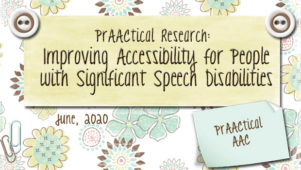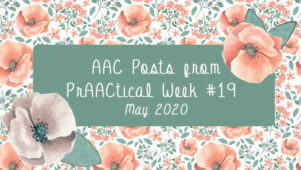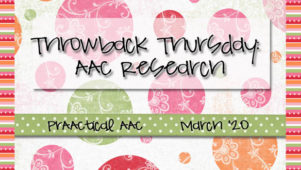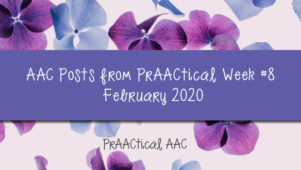PrAACtical Conversations: Nonspeech Oral Motor Exercises

There are some good reasons to use nonspeech oral motor exercises, like blowing, puckering, tongue lateralization, and stretching. For a period of time, I used resistance exercises extensively with one client to improve the resting posture of his articulators and help him keep his mouth closed. Good for hygiene and to reduce his exposure to germs. Using these strategies, lots of children have gained strength and control that allowed them to better bite, chew, and swallow their food.
Oral motor exercises can result in some meaningful gains. According to the research, however, improved speech articulation is not among them.
There have been a number of studies on this approach, including some strong systematic reviews by McCauley and others. This summary by Dr. Greg Lof (Chair of the Department of Communication Sciences and Disorders at Massachusetts General Hospital Institute of Health Professions) is a few years old but is worth another look if you haven’t seen it in awhile. Some of us remember the 2009 ASHA convention where the research was presented to a standing room only crowd of SLPs. The controversy still rages in some circles, and, certainly more research needs to be done. In the meantime, it’s good to see resources such as Dr. Caroline Bowen’s Speech-Language Therapy site address this issue head-on and encourage SLPs to use evidence-based strategies.
–
Filed under: PrAACtical Thinking
Tagged With: controversy, EBP, evidence, nonspeech oral motor exercises, research, resources
This post was written by Carole Zangari





1 Comment
No one needs oral motor intervention unless an oral motor deficit has been determined based on a quantified assessment. Here are the articles citing Beckman Oral Motor
Articles Citing Beckman Oral Motor Intervention
Beckman, D., Neal, C., Phirsichbaum, J., Stratton, L., Taylor, V., & Ratusnik, D.
(2004). Range of movement and strength in oral motor therapy: A retrospective
study. Florida Journal of Communication Disorders, 21, 7-14.
Biro, J., Coker, P., French, L., Lee, J., Martin, M., Mitchum, K., Nguyen, C., & Williams,
K., (2010) Building the Evidence: Using the evidence to create a protocol for
infants with feeding issues. OT Practice May 10, 2010, 9-13.
Fucile et al, (2002). Oral stimulation accelerates the transition from tube to oral feeding
in preterm infants. Journal of Pediatrics, 141, 230-236.
Lessen, Brenda S. (2011). “Effect of the Premature Infant Oral Motor Intervention on
Feeding Progression and Length of Stay in Preterm Infants” Advances in
Neonatal Care 11.2 , 129-139.
Rocha, A. D., Moreira, M. E. L., Pimenta, H. P., Ramos, J. R. M , Lucena, S. L. A
(2007). Randomized study of the efficacy of sensory-motor-oral stimulation and
non-nutritive sucking in very low birthweight infant. Early Human Development,
83(6), 385-388.